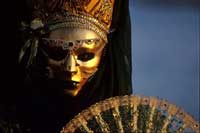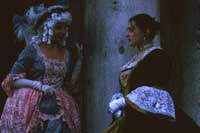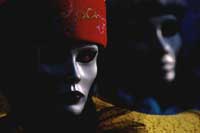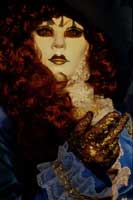 Devotion
of the public to the past and the traditions in Venice has kept
the city undamaged to our day. Most of them being palaces of hundreds
of years, tens of churches and at least that many squares and bridges.
All of them are as marvellous drawings of a fairy tale book. The
people of Venice carry on their faces the taste and happiness of
being a part of this glamorous decoration for generations. This
expression is much more clear during the ten days of crazy and entertaining
Carnival that annually takes place before the Big Fasting, forty
days before the Easter.
Devotion
of the public to the past and the traditions in Venice has kept
the city undamaged to our day. Most of them being palaces of hundreds
of years, tens of churches and at least that many squares and bridges.
All of them are as marvellous drawings of a fairy tale book. The
people of Venice carry on their faces the taste and happiness of
being a part of this glamorous decoration for generations. This
expression is much more clear during the ten days of crazy and entertaining
Carnival that annually takes place before the Big Fasting, forty
days before the Easter.
Carnival is the symbolic reflection of the
image of Medieval Venice in our day.
 The
Venetians, who had given the utmost importance to the concept of
nobility throughout the 1100 years of dukedom and created unbelievable
difficulties to the new settlers and never accepted them, had to
give some wealthy immigrant families (like the Spanish Labbias family)
citizenships against enormous amounts of donations (100000 - 200000
Duke Gold) and involuntarily accepted them to join the nobles, consequently
seem to display their differences by their attitudes and appearances
during the Carnival. The duchesses with their marvellous satin evening
dresses, made by skilled masters -decorated with silver, adorned
with beautiful laces- and with their curly wigs; and the noble gentlemen
with their splendid costumes, big buckled shoes and eye-catching
hats; carry their ancestors' lives, even for 10 days, from some
centuries ago to our day, with the pride seen in their eyes behind
their masks.
The
Venetians, who had given the utmost importance to the concept of
nobility throughout the 1100 years of dukedom and created unbelievable
difficulties to the new settlers and never accepted them, had to
give some wealthy immigrant families (like the Spanish Labbias family)
citizenships against enormous amounts of donations (100000 - 200000
Duke Gold) and involuntarily accepted them to join the nobles, consequently
seem to display their differences by their attitudes and appearances
during the Carnival. The duchesses with their marvellous satin evening
dresses, made by skilled masters -decorated with silver, adorned
with beautiful laces- and with their curly wigs; and the noble gentlemen
with their splendid costumes, big buckled shoes and eye-catching
hats; carry their ancestors' lives, even for 10 days, from some
centuries ago to our day, with the pride seen in their eyes behind
their masks.
The day is theirs. They talk about the Concert of Vivaldi they are
going to watch that day at S. Maria della Pieta as they sip their
morning coffees at Florian. Whose palace they are invited for lunch,
I wonder? Definitely there will be a ball that night. Who knows,
may be the magnificent Casanova will join the ball. What a suspence!
 They
are different; the way they walk, act and talk (The Venetian accent
is privileged.) has always been different. While they dance with
the favourite melodies of the old centuries on the platform set
up at San Marco Square they make the ordinary, simple people, who
are watching them with admiration from behind the barriers dressed
in interesting costumes and ornamented with masks and make-ups,
immediately feel that they are different. They are the fifteenth,
twentieth generation grandchildren of the noble Partecipazio, Orseolo,
Dandolo, Contarini, Mocenigo and Grimaldi families.
They
are different; the way they walk, act and talk (The Venetian accent
is privileged.) has always been different. While they dance with
the favourite melodies of the old centuries on the platform set
up at San Marco Square they make the ordinary, simple people, who
are watching them with admiration from behind the barriers dressed
in interesting costumes and ornamented with masks and make-ups,
immediately feel that they are different. They are the fifteenth,
twentieth generation grandchildren of the noble Partecipazio, Orseolo,
Dandolo, Contarini, Mocenigo and Grimaldi families.
Most of them are brought up and grew at 12th,
13th and 14th century palaces, each with an interesting story, viewing
the Grand Canal, The furniture of their museum houses are of priceless
value and beauty. May be the reason to stand against the unbearable
difficulties of living in Venice (floods, humidity, excessive refurbishment
costs, daily travelling to Mestre, Padova, Treviso, Jesolo for business,
the maddening buzz of tourist crowds, songs ascending from Gondolas)
is catching, even once a year for ten days at the Carnival, the
fascinating atmosphere of the old times. While a Venetian always
passes his daily life among these hundreds of years old buildings
resembling a theatre stage, the costumes and masks are nothing but
the only things that were lacked.
In fact, the tradition of wearing a mask in Venice has emerged in
the 13th century. This tradition had given the Dukes and judges
the chance to walk among the people and collect information on the
events directly. This was also found very useful by the women who
wanted to go to the Cafés, the first of which was opened in 1683
and closed its doors to the women in 1767. Because the long black
gowns and masks could completely hide the sexes of the people as
well as their identities. The masks became more colourful, spread
into more variety and created more characters with the popularity
of Commedia dell' Arte (improvisational folk theatre) in Italy in
16th century. Each region was represented by a different character.
ARLECCHINO, who played the poor servant in his diamond-shape designed
costume, was the most beloved character in Venice. This character,
resembling a clown with his acrobatic actions doubled up the people
with laughter while he made them think with the messages he gave.
Pantalone was the rich old villain, Colombina was the calm and naïve
house girl, and Brighella was the foxy servant.
 The
Carnival that lasted six months, starting at the beginning of September
and ending at the end of February, until 18th century was proclaimed
outlaw, being assumed as the symbol of the Venetian nationalism
during the French and Austrian invasions, then in the periods when
Venetian Dukedom officially ended (1797) and (in 1866) when Venice
was forced to join the Italian Unity that was established in 1861.
This tradition, which the Venetians tried hard to keep alive in
those periods, survived to our day uninterrupted and in 1980 the
complete city accepted to be the venue, discrimination of spectators/players
ended and a declaration was made that everybody could get involved
in the ten days celebrations with costumes and masks.
The
Carnival that lasted six months, starting at the beginning of September
and ending at the end of February, until 18th century was proclaimed
outlaw, being assumed as the symbol of the Venetian nationalism
during the French and Austrian invasions, then in the periods when
Venetian Dukedom officially ended (1797) and (in 1866) when Venice
was forced to join the Italian Unity that was established in 1861.
This tradition, which the Venetians tried hard to keep alive in
those periods, survived to our day uninterrupted and in 1980 the
complete city accepted to be the venue, discrimination of spectators/players
ended and a declaration was made that everybody could get involved
in the ten days celebrations with costumes and masks.
 There
is no doubt that the most important part of the Carnival is the
finale. On the last Tuesday night before the grand fast (farewell
to meat = carnem levare) that is going to last for forty days until
the Easter, ten thousands of costumed and masked people, flowing
into the square through the small and large canals and streets,
impatiently run hither and yon with the excitement of the unsatisfied
entertainment that is going to last to the first lights of the day.
Neither the cold of Venice in February, nor the fatigue of the ten
days prevent them from living this night to the extreme. Music,
drinks, dance, entertainment… These people, behind their masks and
in their costumes, hiding their identities and sexes, live all kinds
of madness to their hearts content with the convenience of being
unrecognised. Neither the cold nor fatigue can stop them. The only
thing that can end the entertainment is the sound of the ringing
bells at the daybreak announcing the start of the grand fast. The
square starts to get loose. The people get out of sight one by one
in the canals and streets they came hours ago. Now the stage is
empty and the players, waking up from a dream, start to go back
to real life.
There
is no doubt that the most important part of the Carnival is the
finale. On the last Tuesday night before the grand fast (farewell
to meat = carnem levare) that is going to last for forty days until
the Easter, ten thousands of costumed and masked people, flowing
into the square through the small and large canals and streets,
impatiently run hither and yon with the excitement of the unsatisfied
entertainment that is going to last to the first lights of the day.
Neither the cold of Venice in February, nor the fatigue of the ten
days prevent them from living this night to the extreme. Music,
drinks, dance, entertainment… These people, behind their masks and
in their costumes, hiding their identities and sexes, live all kinds
of madness to their hearts content with the convenience of being
unrecognised. Neither the cold nor fatigue can stop them. The only
thing that can end the entertainment is the sound of the ringing
bells at the daybreak announcing the start of the grand fast. The
square starts to get loose. The people get out of sight one by one
in the canals and streets they came hours ago. Now the stage is
empty and the players, waking up from a dream, start to go back
to real life.
And the decoration continues to stay in its
place as it has been for centuries. The palace is standing straight
with all its might. Basilica; silently guarding the holy deposits.
Bell Tower; keeping an eye on Venice and the lagoons.
Venice goes back to the enchanted silence
of winter mornings as the tiny waves wash out the steps of Molo
in the morning frost.
EMEL ALTAN EGE 25 February 1998